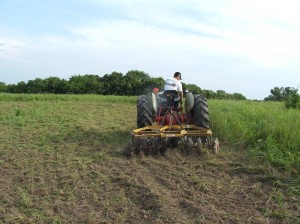Earlier this year we decided to try an electric food plot fencing technique to persuade the local deer herd to stay off a couple of our soybean food plots. The results are starting to come in….

So, these beans don’t look bad. They are relatively thick, have canopied over and look overall to be healthy. But, for this time of year should they look better? These beans are literally adjacent to one of our bean plots that is fenced off. They were planted at the same seeding rate, same fertilizer rate, and on good ground….the only difference is they were not fenced in.

This picture is of Forest literally 20 yards away from the previous picture. The difference, these beans are electrically fenced off. There are no signs of deer browsing in these beans and OHHHHH what a difference it made. By fencing in these beans the deer are browsing the non fenced beans quite a bit. This was done with purpose. The non-fenced beans will provide good forage and attraction keeping the deer from even trying to penetrate our saved beans. These beans will yield better and will last much longer. So far, it looks like our spring work is paying off.
This is also the time to sow in brassicas for late fall and winter hunting. When other preferred food sources are available brassicas will see little pressure from the local deer herd.

For a late fall/winter brassica plot, sow the seeds around mid July. The first step is busting up the ground to expose the soil. Here my good friend Anthony is making several passes with a disc. Ideally, this plot would have been sprayed before hand…but I think we’ll be fine.
This is actually a good thing as the plots will put on tons of forage without any deer pressure…then as the preferred food sources get depleted or perish to hard frosts, my brassicas will start kicking in as the preferred source of food. This can make for some great late season hunting. Right now and until they are gone, alfalfa will remain the preferred food source with soybeans a very close second.
Once you have busted up the ground as in the photo, I usually spread the fertilizer and brassica seed out together. Then I drag or lightly disc the seed and fertilizer in and I’m good to go. When buying your seed, you can pay as much as 5 times the actual cost of the seed by going with a highly marketed name brand seed. I always buy my seed bulk from ag suppliers for a fraction of the cost. A good blend to plant this time of year would be a couple forage turnip varieties, a rape variety, and about half the blend being a non-forage turnip….say 20% each of Barkant turnip, Appin turnip, and dwarf essex rape, along with 40% purple top turnips.

A good fertilizer for brassicas would be triple 17. Put on 2-4 bags per acre.

You can use an atv spreader to spread the fertilizer and seed. With smaller seed like brassicas, sometimes I use a small hand seeder like the one Forest is using here.
If you have other good food sources available throughout summer and fall, don’t expect a lot of deer to be eating on your brassica plots.

A good alfalfa field like this one is hard to beat. Alfalfa is a preferred food source from early spring until several hard frosts have sent the plants dormant.
However, later in the year these plots can be some of the best draws around. Alfalfa and then soybeans will most likely be the best and most attractive food sources around if they are in fact available. But, brassicas have their place in late fall and winter when many times these two food sources are either gone or frozen past their prime.
